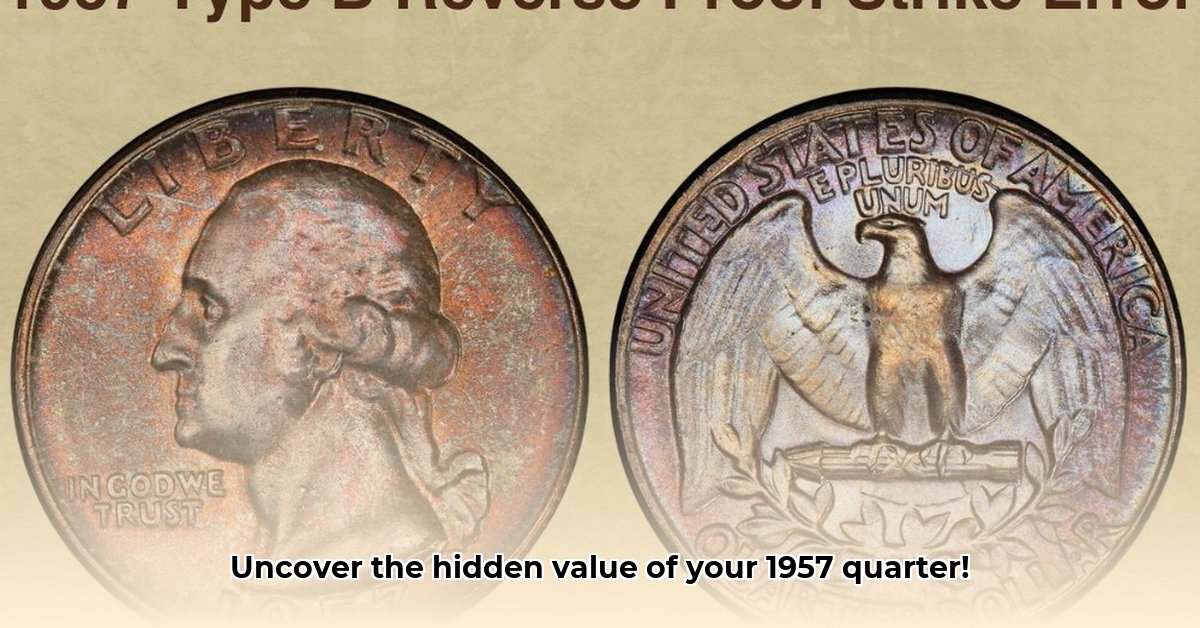
Ever wonder if that old quarter hiding in your change jar is worth more than 25 cents? This guide will help you determine the true value of your 1957 quarter, regardless of whether it bears a Philadelphia "P" or Denver "D" mint mark. We'll explore the crucial factors influencing its price, providing you with the tools to understand what makes your coin special and how much it might be worth. Whether you're a seasoned collector, a curious investor, or simply intrigued by numismatics, this guide will equip you with the knowledge to unlock your 1957 quarter's potential. Let's dive in!
Condition: The Cornerstone of Value
The condition of your 1957 quarter is paramount in determining its value. Think of it like a classic car – a pristine example is worth far more than a well-used one. Numismatists (coin experts) use grading scales, primarily the Sheldon Scale, to assess a coin's condition. A perfect, uncirculated coin, never leaving the mint, commands a premium. Conversely, a heavily circulated quarter will have a lower value. Even well-worn quarters often exceed their face value due to their silver content.
How do you assess condition? Examine the high points of the design – Washington's nose, the eagle's feathers. Are they sharp and well-defined, or smooth and worn? Look for "luster," the bright shine indicating minimal handling. High luster suggests better condition. Coin grading requires practice, a discerning eye, and sometimes magnification, to identify scratches, wear, and other imperfections.
Mint Mark Mystery: "P" or "D"?
A tiny "P" or "D" on your quarter indicates its origin: Philadelphia ("P") or Denver ("D"). While both mints produced 1957 quarters, their mintage numbers differ. While Denver quarters were more numerous, they often exhibit sharper strikes—a factor valued by collectors. That tiny letter on your coin can affect its worth.
Errors: The Unexpected Windfall
Minting errors, rare anomalies in the production process, can dramatically increase a coin's value. These include misstruck dates, off-center strikes, doubled dies (where the design appears twice), and clipped planchets (improperly cut blanks). Finding an error coin is a significant discovery, but they are exceptionally rare. Most 1957 quarters will be standard issues.
Grading and Value: A Quick Reference
This table shows how condition affects value. Note: These are estimates, and market conditions influence actual prices. Many more grading levels exist beyond those shown here. The values provided are general, and actual values may differ.
| Grade | Description | Approximate Value Range (USD) |
|---|---|---|
| MS60 | Noticeable wear | $5 - $20 |
| MS63 | Some wear, details visible | $20 - $50 |
| MS65 | Minor wear, good luster | $50 - $150 |
| MS67+ | Excellent condition, superb luster | $150 - $500+ |
| Proof (PF) | Uncirculated, collector's item | Varies widely, potentially much higher |
Unlocking Your 1957 Quarter's Value: A Step-by-Step Guide
- Mint Mark Identification: Locate the small "P" or "D" near the eagle's wing on the reverse.
- Condition Assessment: Carefully examine the quarter's surface for wear, luster, and sharpness of detail. Consult a coin grading chart for a more precise assessment.
- Error Detection: Look for any unusual features, such as off-center strikes or doubled dies.
- Expert Consultation: For a precise valuation, particularly if you suspect an error coin, consult a professional numismatist or use reputable online resources specializing in coin appraisal.
Remember, this guide offers general guidance. Market fluctuations and other factors can greatly influence your 1957 quarter's actual worth. Professional appraisal is advisable for definitive valuation.
Identifying 1957 Washington Quarter Minting Errors and Their Value
Key Takeaways:
- A 1957 quarter's value hinges upon its mint mark ("P" or "D"), condition (grading), and the presence of minting errors.
- While circulated quarters are inexpensive, high-grade uncirculated specimens, especially those with errors, demand significantly higher prices.
- Philadelphia-minted quarters sometimes lack the sharpness of Denver-minted ones.
- Proof versions were also produced.
- The coin's silver content matters.
- Accurate grading is key to determining value.
- Rarity (due to mintage and errors) greatly affects value.
- Collector demand and auction results drive prices for high-grade coins.
Mint Marks and Their Significance
Identifying the mint mark ("P" or "D") is the first step. The "P" or "D" is located below the date on the reverse. Denver-minted quarters often fetch higher prices.
Assessing Condition: Grading Your Quarter
Coin grading uses scales like the Sheldon Scale (1-70). Circulated coins receive low grades; uncirculated coins (Mint State or Proof) receive higher grades and command higher values. Examine for wear, scratches, and dullness.
Identifying Minting Errors and Their Value Impact
Minting errors significantly increase value. Look for:
- Off-center strikes: The design isn't perfectly centered.
- Broadstrikes: Parts of the design are flattened or unusually wide.
- Doubled dies: The design appears duplicated.
- Clipped planchets: The coin's blank was improperly cut, causing a partial design.
The value increase depends on the error's severity and type.
Determining Value Based on Condition and Errors
This table provides approximate values. Remember, rare errors can dramatically increase these prices; consult multiple reputable sources before determining a final value.
| Grade | 1957-P (Approximate Value) | 1957-D (Approximate Value) | Notes |
|---|---|---|---|
| Circulated (G-VF) | $1 - $5 | $2 - $8 | Significant wear; low value |
| Fine (F) | $5 - $15 | $8 - $20 | Some wear, details visible |
| Very Fine (VF) | $15 - $30 | $20 - $40 | Wear is noticeable, but details sharp |
| Extremely Fine (XF) | $30 - $60 | $40 - $80 | Minor wear, sharp details |
| About Uncirculated (AU) | $60 - $150 | $80 - $200 | Very minor wear; mostly uncirculated |
| Uncirculated (MS60-MS63) | $150 - $300 | $200 - $400 | Nearly perfect; rare |
| Uncirculated (MS65-MS70) | $300+ | $400+ | Gem quality; extremely rare |
For precise valuation, consult a professional numismatist or use specialized online resources.